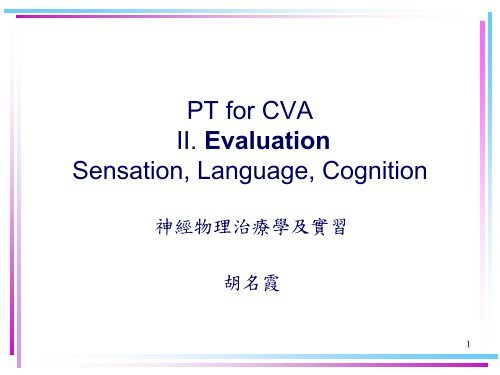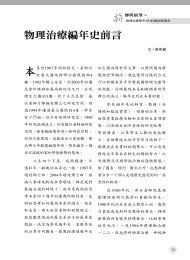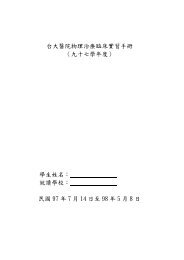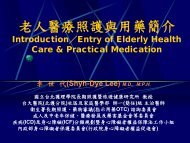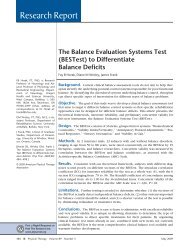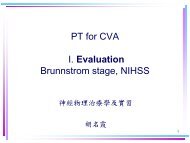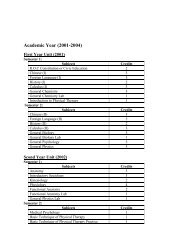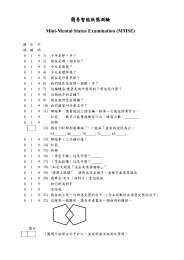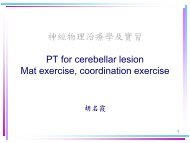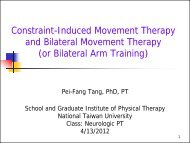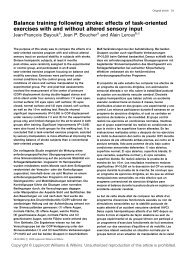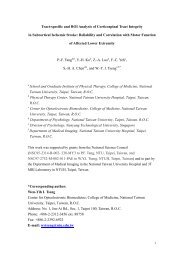PT for CVA II. Evaluation Sensation, Language, Cognition
PT for CVA II. Evaluation Sensation, Language, Cognition
PT for CVA II. Evaluation Sensation, Language, Cognition
You also want an ePaper? Increase the reach of your titles
YUMPU automatically turns print PDFs into web optimized ePapers that Google loves.
<strong>PT</strong> <strong>for</strong> <strong>CVA</strong><strong>II</strong>. <strong>Evaluation</strong><strong>Sensation</strong>, <strong>Language</strong>, <strong>Cognition</strong>神 經 物 理 治 療 學 及 實 習胡 名 霞1
ICF model- 動 作 障 礙 評 估ROMTone<strong>Sensation</strong>perception<strong>Cognition</strong>2
ROM(Umphred, p. 759)3
Muscle tone• Spasticity: a velocity dependentincrease in a muscle’s resistance tosudden passive stretch– clasp-knife phenomenon– Clonus– DTR > ++4
Muscle tone• Rigidity: resistance uni<strong>for</strong>mly increasedin both agonist and antagonist muscles,independent of velocity of stretch• Decerebrate rigidity: full extension• Decorticate rigidity• Cogwheel rigidity• Lead pipe rigidity5
decorticatedecerebrate6
Muscle tone• Hypotonia/flaccidity: decreased orabsent muscle tone• Spinal shock or cerebral shock state• DTR < ++7
Muscle tone/reflex evaluation• Observation• DTR• Jendrassik maneuver• Babinski sign• Passive motion testing• Pendulum test• Drop arm test• Modified Ashworth scale8
Mild, moderate, severe9
vision• Homonymous hemianopsia• Hemineglect• Diplopia• Prosopagnosia: 不 認 得 常 見 出 名 的 臉 孔10
Hemianopia (hemianopsia) 偏 盲• A visual field defect describes sensoryloss restricted to the visual field andarises from damage to the primaryvisual pathways linking optic tract andstriate cortex.11
Homonymoushemianopsia12
Confrontational test <strong>for</strong> hemianopia• Patient looks <strong>for</strong>ward• Static object presented from periphery• Patient state/point when stimuli is detected (yes, now)• Wiggling fingers: easier to detect, <strong>for</strong> severe patients(yes, now)• ‘How many fingers do you see?’• The test requires optimal concentration andcooperation.• 60° in, 100°-110° out, 70°-75° down (Siev et al.,1986)14
Somatic sensation• Light touch/ foot pressure• Pain: Sharp/dull discrimination; pin-prick• Proprioception/ motion sense• Temperature• Stereognosis/Two-point discrimination• Tactile discrimination test• Purpose of test: detect difficulties that mayinterfere with safety, motor control, motorretraining, speed of per<strong>for</strong>mance15
Pain• Location• Type– Pins and needles– Sharp and stabbing– Aching– Dull– pulling• Occurrence– At rest– During movement• ROM exercise• Weight-bearingexercise• Painful arc?16
Keys <strong>for</strong> grading• Intact• Decreased: delayed response• Exaggerated• Inaccurate• Absent• Inconsistent or ambiguous• Hyeresthesia• hypoesthesia17
Sensory agnosia• Astereognosia: 閉 眼 、 病 人 無 法 以 手 摸分 辨 熟 悉 物 件• Agraphaesthesia: 閉 眼 、 無 法 分 辨 治 療師 在 病 人 手 心 寫 的 數 字 或 字 母18
Screen <strong>for</strong> Auditory and receptivelanguage deficits• Simple one step command, eg, ‘shakeyour head no’, ‘give me the pencil’• Note not to gesture• Differentiate among auditory acuity,poor attention, motor planning deficit,receptive language disturbance, ornoncompliance19
Aphasia – dominant hemisphere20
Aphasia – what to do?• Take history from others• Paper and pencil• Discover the first language• Assess understanding– Yes/no questions– Simple 1-step command– Complicated 2- or 3-steps commands21
Mental status• Appearance and behavior– Self-neglect? 髒 、 不 整 潔– Depressed? 皺 眉 、 少 動 、 單 音 調– Anxious? 燥 動 不 安 、palpitation、sweating、hyperventilate– Emotional lability? 易 哭 、 易 笑22
What’s <strong>Cognition</strong>?• Arousal• Attention– Sustained attention > 1 min– Selective attention– Alternating attention• Memory• Orientation• Problem solving– Trial and error or covert solver23
Arousal: Consciousness• Clear/drowsy/coma• Normal, semistupor, stupor, deep stupor, semicoma, coma,deep coma• Glasgow coma scale; Level of CognitiveFunctioning at Rancho Los Amigos Hospital• Elicit response with deep pain– Styloid process– Periosteal surfaces of bones– muscle belly of pectoralis, trapezius– Achilles tendon– Base of finger nails24
What can this test help us understand about the cognition ofthe patient?25
Trail Making B test Scores <strong>for</strong> control subjectspercentile 20-39 40-49 50-59 60-69 70-7990th 45 49 55 64 7975th 55 57 75 89 13250th 69 78 98 119 19625th 94 100 135 172 29210th 129 151 177 282 45027
Memory: digit span–Forward digit span• 7 y.o. = 3• 9 y.o. = 4• 12 y.o. =5• >55 y.o.=4-528
Orientation• What’s your name?• Who is this person?• What date is today ? (Normal within 2days)• What time is our appointment?• Where are we?29
Mentality- JOMAC• Judgment• Orientation• Memory• Abstract thinking: 解 釋 成 語 、 解 釋 兩 物 件的 異 同 、、 估 計 常 見 現 象 的 重 量 或 數 量 等等• Calculation: 100-7, 3x3, (3x3)x(3x3)….30
Perception• Visual perception– Unilateral visual neglect• Body awareness– Unilateral tactile inattention: extinction test– Left and right discrimination• Motor planning– apraxia31
Unilateral spatial neglect• A failure to report, respond, or orient tostimuli in the contralesional hemispacethat cannot be attributed to sensory ormotor impairments.• Unilateral, hemi- neglect, inattention• Prevalence: 12-100% in right brainlesion; 0-76% in left brain lesion; rightside more persistent (Stroke, 1999)32
Albert’s test result interpretationneglect Lines missed % linesuncrossedNo 1-2 4.3uncertain 3-23 4.3-56.8Definite >23 >56.835
Mental tests: MMSE & SLUMS• Mini-mental state examination• Saint Louise University Mental Statusexam– http://www.stlouis.va.gov/GRECC/Education.asp– 胡 名 霞 ,2010, 長 期 照 護36
Extinction test• Test right, left side light touch sensation• Then touch both side simultaneously,ask ‘how many fingers is touching you?’37
Right left discrimination test• Show me your right hand/leg.• Show me your left hand/leg.• [Give the patient a pen.] Put the pen inmy right hand.• [Place the pen on the patient’s left side.]Is this pen on your right or left side?38
Body image perception• Hemineglect: 病 人 能 不 能 找 到 偏 癱 側 的手 ?• Anosagnosia: 不 知 道 一 ( 左 ) 側 較 無 力 ,且 請 她 往 左 的 時 候 常 常 往 右• Asomatagnosia: 看 到 自 己 的 ( 左 ) 手 不 認識 R’t/L’t agnosia: 病 人 無 法 用 右 手 碰 左耳 , 或 你 把 左 右 手 交 叉 , 病 人 分 不 出 來39
Summary: Perceptual Deficits• Left hemisphere• <strong>Language</strong> and temporalordering– Apraxia– Sequence– Directionality– Low frustration level– Verbal and manualperserveration– Compulsive– Extreme distractability• Right hemisphere• Spatial-global– Hand-eye coordination– Figure-ground– Position in space– Poor judgment– Unrealistic– Denial– Unable to abstract– Rigidity of thought– Poor body image andscheme– Distort time concept– Short attention span– Lethargy appearance40
Treatment of visual neglect (Bailey et al., 2002)• Scanning and cueing techniques– 主 動 地 由 左 向 右 掃 視 (scan) 近 、 遠 物 件– 左 側 置 放 醒 目 物 件– 由 簡 單 ( 如 單 行 文 字 ) 到 複 雜 ( 如 多 行 文 字 )– 逐 漸 增 加 複 雜 、 使 分 心 的 物 件– 鼓 勵 及 獎 勵 成 功 的 練 習• Left limb activation techniques– 告 知 多 用 左 手 可 改 善 neglect– Active, active assist functional use of left limbs– 用 左 手 活 動 ( 如 tapping) 來 提 醒 注 意 左 側 (15 min)– 各 類 生 活 中 的 活 動 , 如 梳 頭 、 倒 水 、 開 罐 子 ..(30 min)– 左 手 擦 拭 白 板 、 桌 面 等 … (15 min)41
Motor Planning test• Sequence: 例 如 刷 牙 的 順 序• Perseveration: 例 如 一 直 刷 同 一 邊 的 牙 齒• Object use: 使 用 器 具 的 方 式 對 不 對• Gesture: OK, bye-bye• Facial motion: blow off a candle• Motor patterns: difficult initiatingmovement?• Interpretation: no, partial, severe deficit42
Apraxia (dyspraxia if mild <strong>for</strong>m)• Disorders of the execution of learnedmovements which cannot be accounted<strong>for</strong> by either weakness, inco-ordination,or sensory loss, nor byincomprehension of, or inattention tocommands (Geschwind, cited in vanHeugten, 2001)• Brain region involved– sensory area: left inferior parietal– motor areas: left or right premotor andsupplementary motor 43
Types of apraxia• buccofacial or orofacial apraxia (most common)– inability to carry out facial movements on command such as licking lips,whistling, coughing, or winking.• limb-kinetic apraxia– the inability to make fine, precise movements with an arm or leg• ideomotor apraxia– the inability to make the proper movement in response to a verbal command– Deficits in pantomiming tool use and gesture• ideational apraxia– the inability to coordinate activities with multiple, sequential movements,such as dressing, eating, and bathing• verbal apraxia– difficulty coordinating mouth and speech movements• constructional apraxia– the inability to copy, draw, or construct simple figures• oculomotor apraxia– difficulty moving the eyes on command44
Motor planning test: imitation of posture• Mirror the therapist’s movement– (trial) Put your fist on your chin.– Put your hand under your elbow.– Pinch one thumb with the opposite thumb and middlefinger.– Clasp your hands and bring them to your hip.– Clench your fist. Place your hand on your chest. Makea V with your index finger and middle finger. (3-stepcommands.)• Follow verbal commands– … or ‘Clasp your hands, touch your left shoulder, touchyour right knee.’45
Interventions <strong>for</strong> motor apraxiafollowing stroke (West et al., 2008)• Cochrane reviews; published inStroke.2009; 40: e396-e397 by Bowenet al.• There was evidence of a small andshort-lived therapeutic effect in the twostudies that reported change in activitiesof daily living (102 participants) but thiswas not considered clinically significantand did not persist at the longer-termfollow up.46
Reference and additional reading• Okkema, K (ed.) <strong>Cognition</strong> andPerception in the Stroke Patient: Aguide to Functional Outcomes inOccupational Therapy. Gaithrsburg, MA:Aspen Pub, 1993.• 蔡 佩 玲 、 胡 名 霞 。 腦 中 風 張 力 評 估 in 物理 治 療 。47
Stroke warning sign quiz• http://www.strokeassociation.org/STROKEORG/WarningSigns/StrokeWarningSignsQuiz/Stroke-Warning-Signs-Quiz_UCM_308584_Article.jsp48


